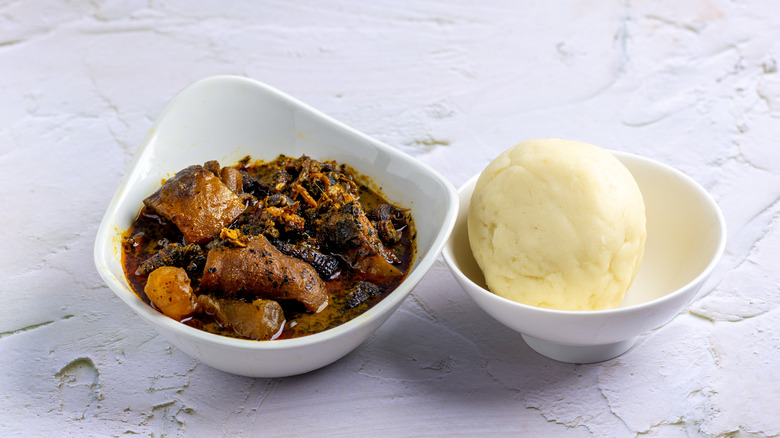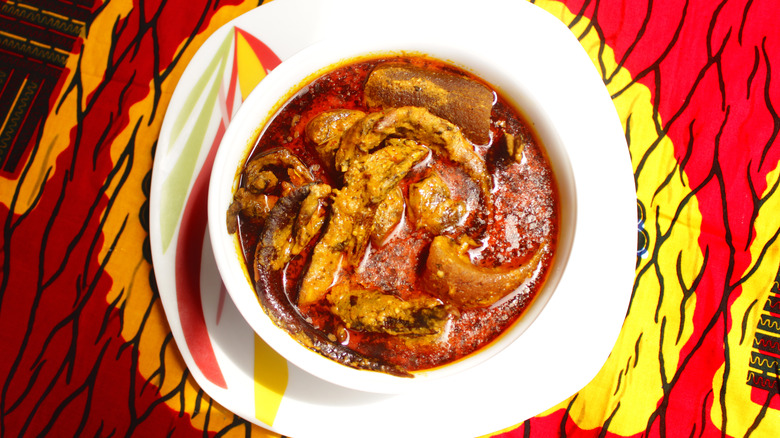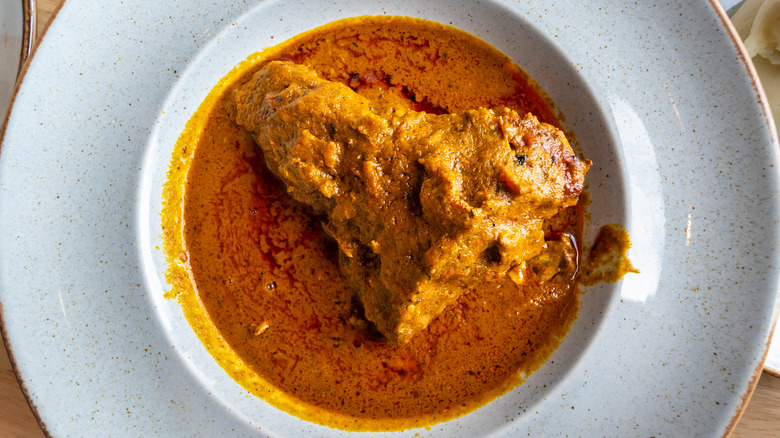Banga, The Nigerian Soup That Stars A Rich Blend Of Spices
When it comes to Nigerian food, warm, fragrant dishes dominate the cuisine. In a country with over 300 tribes from many different ethnic groups and an extensive food history, the likes of suya, jollof rice, and egusi soup are often the most popular dishes. While the spicy, aromatic flavors in these dishes represent the cuisine well, exploring lesser known foods like banga soup is an absolute must.
Hailing from the southern region of Nigeria, banga soup is a rich soup made from meat or fish, palm nut fruit concentrate, and an assortment of spices and aromatics, such as Cameroon, habanero, and scotch bonnet peppers. Banga also contains oburunbebe sticks, sometimes called African licorice sticks. Like other soups from Nigeria, it's eaten with "swallow," a type of side dish that is dipped into your soup of choice and swallowed, not chewed. Banga can be eaten with eba, a swallow made from fried cassava, or pounded yam, which is made from peeled, boiled yams. The ethnic groups that created banga eat it with delta starch, which also comes from cassava.
Banga soup has a savory, spicy taste, however, the foundation of it comes from palm nut cream. Palm nut soup is eaten across West Africa, with each country and ethnic group delivering their own special take on it. With banga soup, the unique spices and aromatics that are native to Nigeria enrich the soup, giving it its own earthy flair.
Where did banga soup originate from?
Although banga soup is enjoyed by a variety of Nigerians, the ethnic groups in the Niger Delta are to thank for the dish, particularly the people of the Urhobo and Itsekiri tribes. There's no specified time period for when it originated, but its star ingredient has deep roots in the country's history.
The oil palm tree, which produces red palm oil as well as palm nut concentrate, grows in the Niger Delta and has been in the country for thousands of years. The oil palm fruit and everything that's derived from it have always held significance. For Urhobo and Itsekiri people, as well as the other groups found in the Niger Delta, banga soup is present at special events, such as traditional wedding ceremonies.
While the protein in banga soup is dependent on the preferences of whoever prepared it, seafood is traditionally used. The region gets its name from the river that runs through it, providing it with the crabs, snail, catfish, periwinkle, and crayfish that flavor banga soup. Although oil spills from international companies have polluted the water throughout the Delta, its fresh and dry seafood remain integral to the rich taste of banga soup.
How is banga soup made?
The main ingredient in banga soup is palm nut cream. Extracted from the fruits of the oil palm tree, the cream has a deep, nutty flavor. Typically sold in tin cans, the thick paste needs to be diluted with water and stock from the meat or fish you cook. Add your meat and fish to a large pot and season it with salt, aromatics, and bouillon cubes. Once your protein is finished cooking, remove it from the pot and pour the palm nut cream into the pot.
While the palm nut cream is simmering, blend some onions and scotch bonnet peppers to stir into the mixture. Although the palm nut cream provides the soup with a nutty taste, the spicy, earthy flavors come from the banga spice, which contains a variety of spices such as African nutmeg and a blend of ataiko and irugeje seeds. Tracking down individual spices can be difficult, but you can find blends of them at African grocery stores or online. Once you've sprinkled in the spices, add your meat back to the pot and allow the soup to simmer for about 10 to 15 minutes, stirring occasionally. When the banga soup starts to thicken, take it off the stove and serve with the swallow of your choice.


